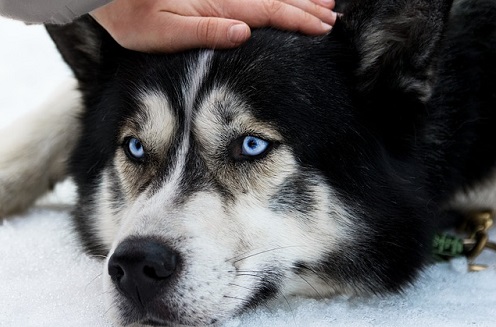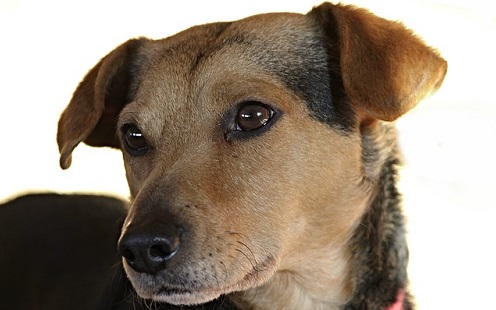Finding out your dog has cancer is devastating. Getting the diagnosis from your veterinarian is overwhelming, and it’s understandable if you don’t retain all the information and treatment options they offer you. Just like humans, chemotherapy is a treatment option for dogs with cancer. Before deciding which treatment route to take, you’ll want to have a thorough understanding of chemotherapy for dogs including cost, side effects, and length of treatment. Here’s what you need to know.
What is Chemotherapy for Dogs?
Both humans and dogs diagnosed with cancer can be treated with chemotherapy and the process is not much difference between the two. However, chemotherapy dosage for dogs is less substantial than that of humans. Since canines live relatively short lives, the primary goal of chemotherapy treatment is to provide them with the best quality of life for as long as possible.
As with all veterinary treatment, there are pros and cons associated with chemo for dogs. When your cherished dog gets cancer, you will most likely be on the fence about whether or not to pursue aggressive medical treatment. Pet owners should do their research and weigh the advantages and disadvantages before making such a huge decision.
Although chemotherapy for dogs can be a challenging process, it is much less grueling than treatment in humans. The reason for this is because a dog with cancer will not receive the same amount of intensive medications as a person going through chemo.
Chemotherapy treatment for dogs consists of a group of medications that have the potential to kill cancer cells. The specific amount and combination of drugs will depend on your dog’s age, overall health, and type of cancer he has. During chemo treatment for a dog, a veterinarian cancer specialist will monitor the treatment closely. Under the care of your vet, your pup will be closely observed regarding the effectiveness of the therapy as well as any side effects. Throughout the chemo treatment process, the type of medication and dosage may be adjusted.
 Chemo is often recommended for cancer that has begun to spread to other areas of a dog’s body or types of cancer that are known to metastasize. A veterinarian’s recommendation for chemotherapy for a canine will depend on whether the cancer has already spread, the age of the dog, and if surgical tumor removal is an option.
Chemo is often recommended for cancer that has begun to spread to other areas of a dog’s body or types of cancer that are known to metastasize. A veterinarian’s recommendation for chemotherapy for a canine will depend on whether the cancer has already spread, the age of the dog, and if surgical tumor removal is an option.
If the tumor in the dog is small enough, it might be able to be surgically removed. To determine the likelihood of growth, a veterinary lab specialist will examine a sample of the cancerous cells under a microscope. The veterinary pathologist then grades the cancer on its potential to metastasize. Based on this grade, chemotherapy may or may not be recommended for a dog.
How Much Does Chemotherapy for Dogs Cost?
The cost of chemotherapy for dogs depends on a number of factors including the type of cancer, duration of treatment, and medications used as well as the veterinary options offered in your area. Chemo treatment for canines will most likely cost between $3,000 to $5,000, but some pet hospitals charge $10,000 or more.
Some less expensive chemotherapy options for dogs consist of single doses which range in price from $25 to $50 per injection. Chemotherapy for dogs is often covered under pet insurance. Talk to your pet hospital about treatment plans and payment options that are best fit your unique scenario and budget.
How Does Chemotherapy for Dogs Work?
Most chemo will be administered to a dog through a series of intravenous injections. The chemotherapy injections usually last a few minutes, but some can take a few hours. The majority of appointments for canine chemo will last for a half hour to an hour. In addition to the injection, the veterinarian will assess your dog’s current health condition, take blood samples, and note any side effects of the treatment. Pet owners are typically required to fill out some paperwork and are sent home with detailed care instructions after each appointment.
Some types of chemotherapy for dogs can be given orally by a veterinarian or pet owner. Oral medication usually comes in pill form. If you are to administer the pills to your dog yourself, your vet will provide you with detailed instructions. It’s important to store any chemotherapy drugs in a secure container in your refrigerator away from any other medications.
How Long Does Chemotherapy for Dogs Take?
The duration of chemotherapy for dogs depends on the type of cancer as well as how much the disease has spread. If your dog has lymphoma, standard chemo will usually last 20 to 24 weeks. Once initial treatment is complete, your dog will be in remission. During this time, injections will be stalled, and you and your vet will wait to see if the cancer returns. Most other types of chemotherapy in dogs will last for about three months.
The frequency of chemo treatment will also depend on what type of cancer the dog has and which drugs are used as well as their overall health. Most chemotherapy treatment sessions for dogs will occur every four to six weeks.
What are the Side Effects of Chemotherapy for Dogs?
 The side effects of chemotherapy for dogs are generally less severe than in humans. About 75 percent of dogs will not exhibit any side effects of the treatment. Less than 5 percent of dogs will suffer from severe cases of these side effects and should be brought to the pet hospital as soon as possible for supervised care.
The side effects of chemotherapy for dogs are generally less severe than in humans. About 75 percent of dogs will not exhibit any side effects of the treatment. Less than 5 percent of dogs will suffer from severe cases of these side effects and should be brought to the pet hospital as soon as possible for supervised care.
If your dog does have adverse reactions to chemotherapy, they will typically include vomiting, diarrhea, and appetite loss. These side effects will usually surface a few days after a treatment session, but some dogs may experience them immediately. In most cases, chemo side effects related to an upset stomach will resolve on their own. However, pet owners should be mindful of chronic vomiting and diarrhea as they can cause dehydration.
Chemo drugs are designed to destroy cancerous cells, but unfortunately, they kill both normal and abnormal cells during treatment. This problem can lead to loss of bone marrow and in turn, low white blood cell count. White blood cells assist the immune system, so a low count puts your pet at risk for canine bacterial infections and other illnesses. Some dogs undergoing chemotherapy will exhibit extreme lethargy and will need to rest for a few days following an injection.
Most dogs that undergo chemotherapy do not suffer from canine hair loss, although some breeds are more prone to this side effect than others. Poodles, Bichon Frises, and Old English Sheepdogs are susceptible to hair loss during chemo treatment. Some dogs may lose their guard hairs or whiskers.
Types of Cancer in Dogs
Dog breeds prone to cancer include Bernese Mountain Dogs, Rottweilers, German Shepherds, Labrador Retrievers, Boxers, and Great Danes. Chemotherapy for dogs is most commonly administered to treat lymphoma. However, dogs can be diagnosed with several different types of cancer including canine melanoma, mast cell tumors, bladder cancer, breast cancer, and hemangiosarcoma.
Lymphoma
Lymphoma is a type of cancer that affects a dog’s lymphoid system. This variety of cancer is derived from white blood cells called lymphocytes.
Melanoma
Melanoma is a type of skin cancer that affects melanocytes (pigmented cells) of a dog. It is usually found in a canine’s mouth, mucous membranes, or hair.
Mast Cell Tumors
Canine mast cell tumors are one of the most common kinds of cancer found in dogs. A mast cell tumor is usually found in the skin and is related to blood cells that connect with an animal’s response to inflammation and allergens.
Bladder Cancer
Bladder cancer in dogs refers to a malignant tumor found in a canine’s bladder. Bladder tumors are prone to spreading to a dog’s lungs, lymph nodes, and bones.
Breast Cancer
Breast cancer in dogs (or mammary cancer) is a common type of cancer found in female canines. Unspayed canines are more at risk for developing mammary tumors than spayed dogs.
Hemangiosarcoma
Canine hemangiosarcoma is highly malignant. This type of cancer is found in dogs and attacks the blood vessels. It metastasizes rapidly and can lead to tumors in the heart and spleen as well as other parts of the body.
Alternative Treatments for Cancer in Dogs
 In addition to surgery and chemotherapy, some dogs are treated for cancer through immunotherapy.
In addition to surgery and chemotherapy, some dogs are treated for cancer through immunotherapy.
The immunotherapy vaccine is used to stimulate a dog’s immune system so that it can attack the cancer. This type of alternative cancer treatment is most commonly used to treat dogs with melanoma. Bone marrow transplants are beginning to be used to treat some dogs with cancer. Be sure to ask your veterinarian about any new treatment methods or clinical trials.
Pros & Cons of Chemotherapy for Dogs
Chemotherapy is taxing for both dogs and their owners. It’s important to get all the facts before deciding to move forward with treatment. Get to know the pros, cons, and basic information surrounding chemo treatment for canines.
Chemotherapy:
- Treats most types of cancer in dogs
- Can be administered by a growing number of veterinary professionals
- Is the most effective treatment option available for canine cancer
- Can immediately take effect
- Is an expensive treatment option
- Is time-consuming
- Causes side effects in some dogs
- Does not guarantee that cancer will not recur
- Does not ensure the prolonged life of a pet
Dogs are a cherished part of the family and a canine cancer diagnosis can come as heartbreaking news. It’s understandable that pet owners want to do everything they can to treat their suffering pup. Before signing your dog up for chemotherapy treatment, be sure to consider all of the above factors. Unfortunately, the chemo is not always effective in treating cancer. Pet owners should be aware of this fact before committing to the cost, time, and potential side effects of the exhausting treatment journey. It is also worth noting that many people explore natural remedies for dogs with cancer as an alternative option. If you do not choose to treat your dog with chemotherapy, it is just as honorable to shower them with TLC and give them a great life for the remaining time they have.




